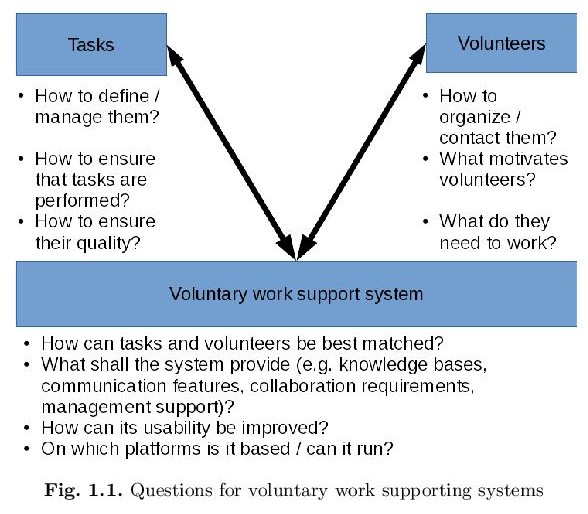Harald Alfred Weiner, Seminararbeit, JKU Linz 2015.
Introduction: Non-profit organizations (NPOs, sometimes also called non-government organizations, NGOs), like the Red Cross, rely on volunteers who contribute their time on executing various types of tasks, where some of them need people to be in attendance and others can be done via computer access over the world wide web. No matter how the tasks are done (off-line or on-line), tools can support organizations’ work-flows and improve collaboration. Wikipedia is a positive Web2.0 example where technology has been a key-driver for a voluntary work support system, in this case an on-line collaboration tool.

This paper will first give a brief overview of what is essential to consider about motivating volunteers, what work support system types in general exist yet, then derive a list of criteria and finally apply them on existing software products in the eld of (voluntary) work support systems. Because motivation is essential to perform voluntary work the second chapter will discuss concepts of human motivation and empowerment theories. It will address what voluntary engagement means, what are the differences between intrinsic and extrinsic motives, how gami cation can help to keep people motivated over time and other psychological factors for motivation of individuals. To be motivated, volunteers need knowledge about how to perform the task and so on. Volunteers and employees of NPOs need to contact other people and, for example, call them to recruit them for several tasks. Customer-relationship-systems (CRM) and web-sites for NGOs can not only serve as a single source of information for employees, volunteers, donors and journalists but also enable better management of contacts, activities and communication inside and to the outside of the organization. As social-media networks and CRMs are that important for connectedness between people some of their main characteristics are discussed in the third chapter. Another type of software products for working are work-flow management systems which will be explained in the forth chapter. Work flow management systems are based on extended Petri-nets which have a strong mathematical foundation and a graphical notation. This makes them perfect for designing and re-engineering business processes by humans while computers can perform automated measurements, correctness checks, execute the processes and monitor their life-cycles. Crowd-working platforms are a relatively new type of work systems. Crowd-sourcing, as the synonym for crowd-working, is a new phenomena where a lot of human workers can be recruited on-line from all over the world. Each of them performs a simple micro-task but in total they accomplishes gigantic and complex work-loads. The current research on this interesting topic, e.g. task routing, is also relevant to off-line voluntary work supporting system. How the task creation, assignment and execution works will be explained in the fifth chapter. As this seminar paper is about tools and systems, the sixth chapter will introduce a list of criteria for evaluating voluntary work supporting systems. In the seventh chapter available software products are chosen and compared to each other on base of the list of criteria. The last chapter will conclude the evaluation with a summary and ideas for further research.
